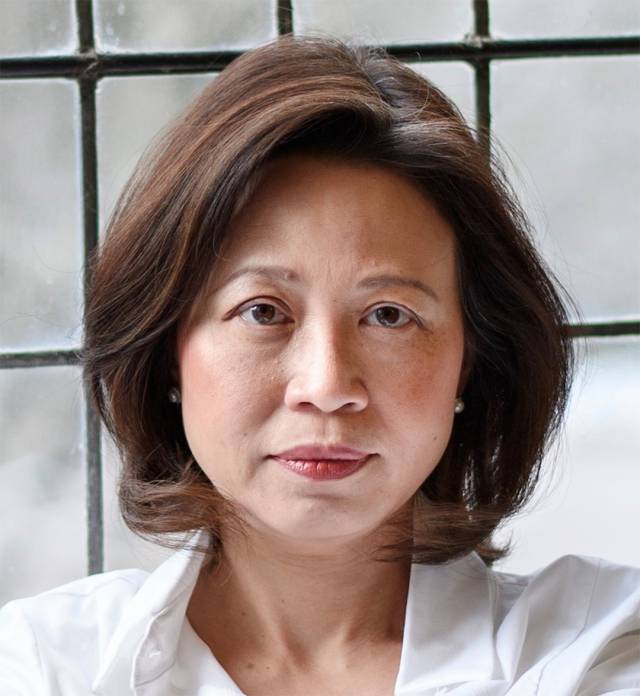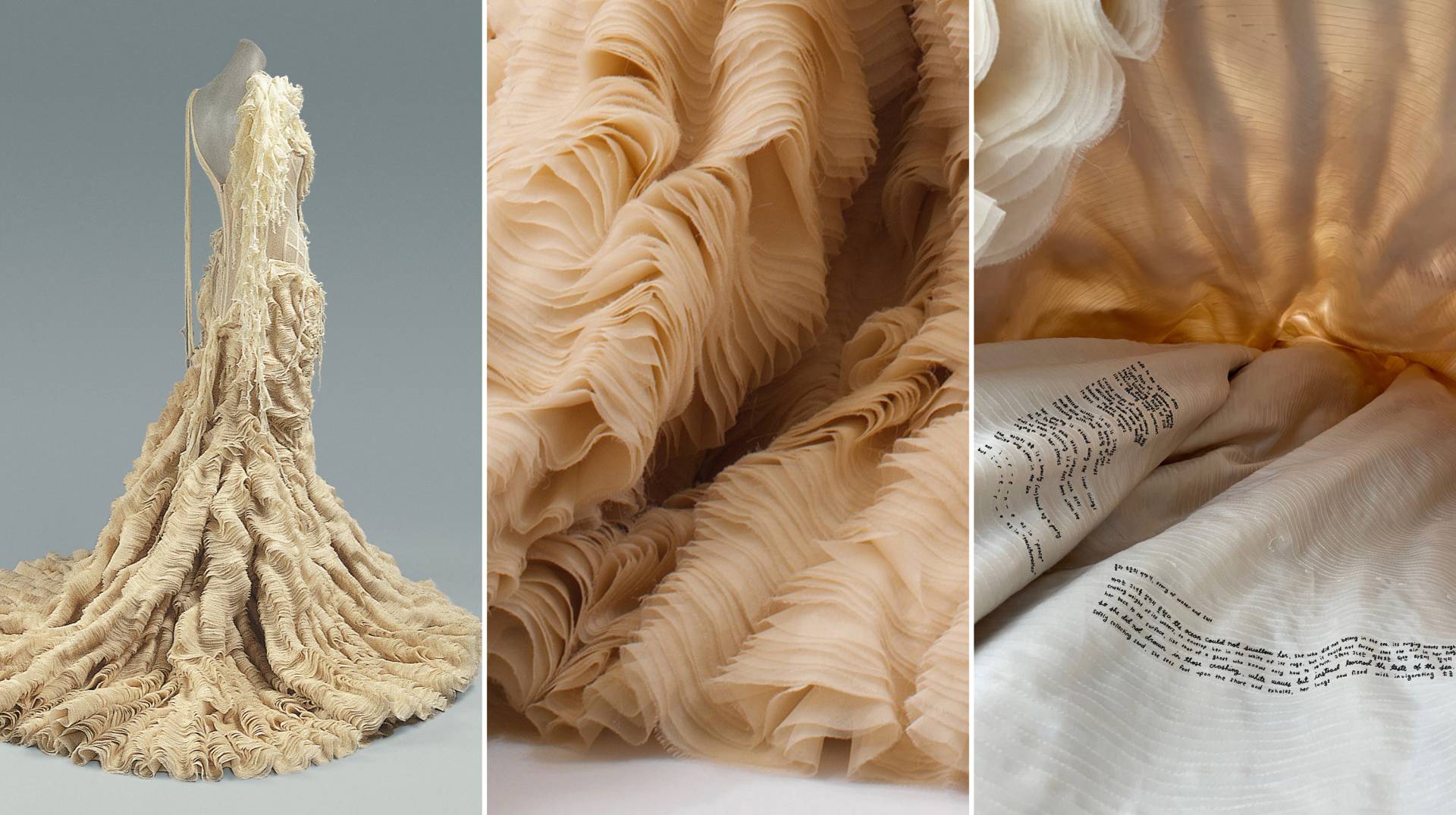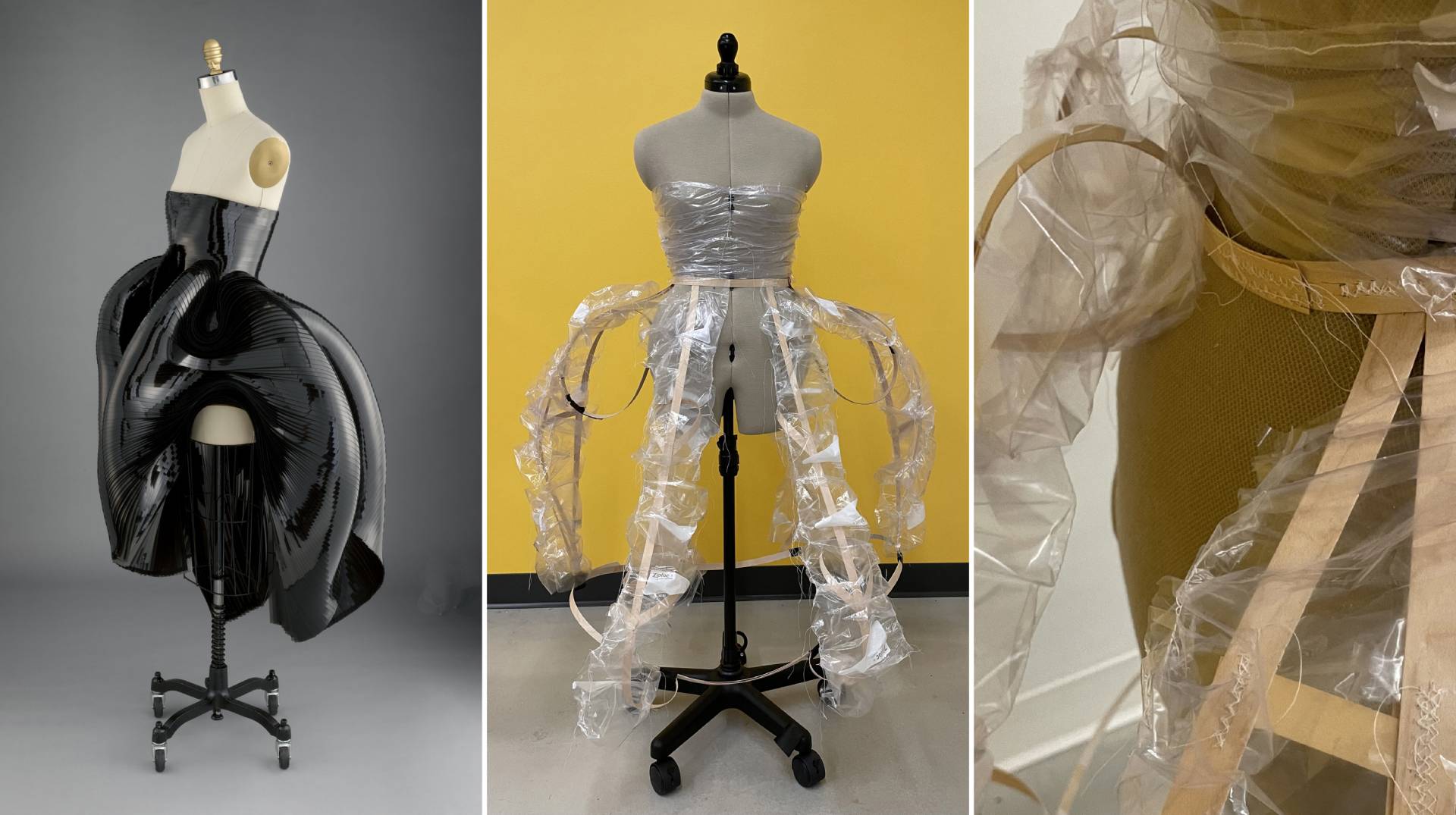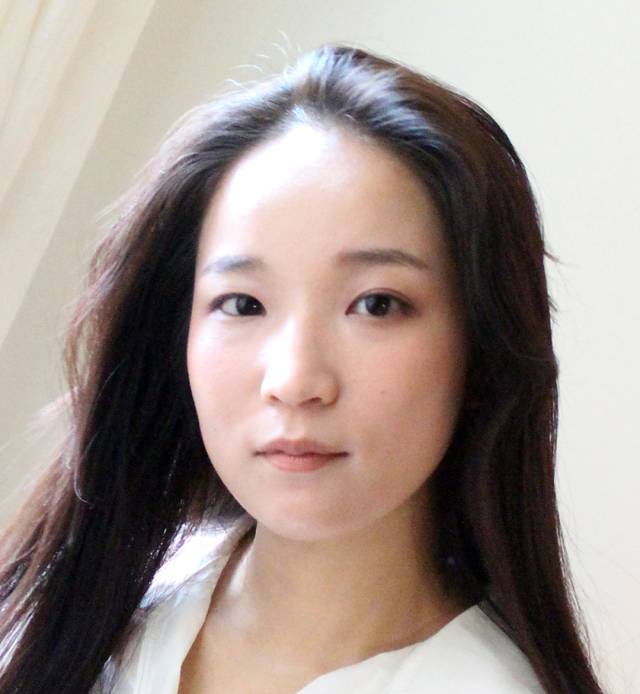In the fall course “Literature and Fashion,” students explored novels and films using fashion as their filter for concepts and ideas about how people see us and how we see ourselves. Pictured: Junior Lena Hoplamazian (standing) presents her final project, a re-imagining of a dress from the MET Costume Institute, which the class visited.
“People usually think about fashion as something superficial, irrelevant or just materialistic,” says Anne Cheng, professor of English. “But philosophers and writers have known for a long time that it also generates formative meanings about how others identify us and how we identify ourselves.”
In the fall course “Literature and Fashion,” co-taught by Cheng and graduate student Moeko Fujii, students explored novels and films using fashion as their filter for these concepts and ideas.

Anne Cheng
“It turns out literature and film are obsessed with fashion,” Cheng said. “Once we started thinking about this class, the historic span really amazed us.” Readings included Émile Zola's 1883 novel “The Ladies’ Paradise” about the first department store in France, Jane Austen's “Pride and Prejudice,” Joan Didion’s 1979 essay about the importance of packing well, and more. Films included Hitchcock’s “Vertigo" and Wendell B. Harris Jr.'s "Chameleon Street," among others.
“There are all these wonderful profound meditations about clothes, as well as style, that are really about questions of the self, class, race and gender,” said Cheng, who received the President’s Award for Distinguished Teaching in 2022. “And you cannot talk about fashion without also talking about money, globalization, material culture, labor, craftsmanship and art. It’s an inherently interdisciplinary topic, which helps students develop a more integrated way of thinking.”
Fashion, the class learned, can even embrace architecture. In “Pride and Prejudice,” for example, Mr. Darcy’s house becomes an arbiter of taste that ultimately wins over Elizabeth Bennett — more than Darcy himself, Cheng said.
“In class we talked about how Elizabeth initially rejects Darcy’s wedding proposal but seeing Pemberley for the first time gave her pause. Austen gives us a long description of the house — about a page and a half on its style, how it’s built, how it's landscaped. The whole point for Austen was not just that it was a fancy rich house, but a rich house with taste. Elizabeth really fell in love not first with Darcy, but with Pemberley. Here architecture articulates taste, and style itself becomes almost like a protagonist.”
A course collaboration and an haute couture class trip
Fujii is Cheng’s research assistant, and they quickly discovered they both have a passion for fashion through an academic lens. Together, they spent the better part of two years developing the syllabus and were able to co-teach the course through the Collaborative Teaching Initiative, sponsored by the Office of the Dean of the College and the Graduate School.
Cheng called it “a true collaboration” every step of the way, from designing the syllabus to the course application — which invited students to write 500 words about designer Li Xiaofeng’s 2009 “armor-dress” made out of porcelain shards — to taking turns leading the seminar discussions.
Early in the planning, Fujii reached out to her childhood friend Mika Kiyono, now an associate publicist at the Metropolitan Museum of Art Costume Institute. The two met in middle school in Tokyo and both came to the U.S. for college.
“I floated a thought: how amazing it would be if our students could visit the Costume Institute's archives,” Fujii said. “In my experience, nothing helps students think better than when they're walking around objects, asking questions, thinking hard about what fascinates them or what makes them uncomfortable.”
On the trip, students met collections management staff, viewing garments from British designer Alexander McQueen’s Oyster Dress from his 2003 collection to a futuristic dress from Dutch designer Iris van Herpen’s 2013/14 collection.
The course culminated in a virtual exhibition. Students selected an object from the Costume Institute and created an original “alteration” to make the viewer think differently about the object and wrote a catalogue essay with their reflections about a text or film from the syllabus. View their virtual exhibition online.

For her final project, sophomore Grace Kim, inspired by Alexander McQueen's Oyster Dress, re-imagined the designer's narrative about the dress and wrote her own stories and poems in English and Korean.
Sophomore Grace Kim was immediately drawn to McQueen’s Oyster Dress, a billowing design made of hundreds of layers of sand-colored silk organza, georgette and chiffon that mimic the ridging on the surface of a shell etched over time by the sea.
“Seeing the spread of those stitch lines across the inside of the skirt made me think of a blank sheet of notebook paper, as if the beauty of the dress was not just in its stunning exterior but also within its narrative that had yet to be fully written,” Kim said.
McQueen always built his collections around a narrative; his 2003 collection was based on a shipwreck at sea and a girl’s survival. For her final project, Kim was inspired by one of the class readings, “A Manifesto for Cyborgs” by Donna Haraway. “I imagined the surviving girl to be a woman of color, specifically an Asian American woman like myself,” Kim said. “I reimagined the Oyster Dress to be a cyborg by writing my own stories about the shipwreck and subsequent survival, telling them in poems written in English and Korean — my native tongue and my mother tongue.”
Kim printed a close-up photo she had taken of the dress on the Met trip and hand-wrote poems along the inner stitch lines of the dress. “I hoped that my message — that the language and stories of women of color are intricate, important and thus beautiful — would be nestled within the intimate nature of handwritten poetry,” she said.
Junior Lena Hoplamazian, a history concentrator who is also pursuing certificates in architecture, engineering and South Asian studies, chose the van Herpen dress, made from strips of molded black PVC plastic.

Junior Lena Hoplamazian reimagined a dress by Iris van Herpen: “Instead of an exoskeleton, I wanted an internal skeleton, and materials that were ordinary and transparent, as opposed to the expensive, dark and mysterious material of the original,” she said. Her accompanying catalogue essay riffs on the idea in Bill Brown’s essay “A Sense of Things,” one of the class readings, that we must see through objects to find the subject within.
A self-taught sewer and designer, Hoplamazian is a sewing and embroidery machine technician in the Council on Science and Technology’s Studio Lab, a creative technology maker space that is open to all members of the University community. “Studio Lab is my heaven, because it lets me experiment, and fail, freely and often,” she said.
On a shift at the Studio Lab, she found a huge pile of Ziploc bags and thin, wooden strips. She experimented until she figured out how to run these materials through the sewing machine. Her dress is strapless and shaped like the original but with a bodice made of Ziploc bags and a hoop skirt made of looped wood strips sewn together and covered in Ziploc panels.
“Instead of an exoskeleton, I wanted an internal skeleton, and materials that were ordinary and transparent, as opposed to the expensive, dark and mysterious material of the original,” Hoplamazian said. Reflecting on the idea in Bill Brown’s essay “A Sense of Things” that we must see through objects to find the subject within, her catalogue essay riffs on van Herpen’s opaque dress: “As a garment, we know nothing about its wearer. To imagine a dress like van Herpen’s that allows us to come within, I have created an alteration.”
This was the first English course Hoplamazian has taken at Princeton. “The class legitimized the idea that there are so many worthwhile questions to be asked of fashion and design, and so many people providing rigorous, paradigm-shifting answers,” she said. “The ideas Professor Cheng and Moeko exposed me to will inform the direction of my independent work and the direction of my life beyond Princeton.”
Humanist perspectives for STEM students
Two of the 10 students in the seminar are concentrating in STEM fields. Both said the class complemented their STEM coursework in valuable ways.
Junior Anurag Pratag, a computer science concentrator, took a course with Cheng his first year at Princeton and was eager to take another.
“Professor Cheng creates a classroom which is rigorous in the questions it asks and in searching for the answers. She has made me want to be a better thinker, a better writer, a better reader. She makes us ask about things which are so common in our everyday lives that we forget to pause and consider them critically.”
Pratag has also taken courses in sociology and architectural theory, along with creative writing seminars.
“It is often easy to forget the beautiful and chaotic things of everyday life, or to take measure of a day meaningfully, when I am deep in studying molecules, cells or code,” he said. “These [arts and humanities] courses help me imagine, reimagine and critique the most mundane and surreal moments in my own life and that of others. A humanist lens offers me a hidden backdoor into problems, whether it be considering the burden of illness or imagining artificial intelligence.”
Senior Elisabeth Rülke is a physics concentrator who has taken courses in history, philosophy, religion, film and visual arts. An international student from London, she said one of the main reasons she chose Princeton was because its “liberal arts education allows you to take classes in a range of subjects, and what you choose to major in isn’t the only focus of your education, as is the case with most British universities.”
Rülke said she was excited to see two of her passions — humanities and fashion — combined. “This course definitely impacted my thinking about topics such as identity, expression and consumption.”
Cheng hopes that the class will change the way students look at the world and at themselves, no matter what their majors are.
“Unless we can see the world differently, we can never hope to change it,” she said. “In order to have that transformation, you have to step outside of your comfort zone and see things from different angles. I also want them to think harder about how they judge other people when they look at them and how they judge themselves.”

Moeko Fujii
She said the fact that the course itself was co-taught helped this process. “It's so important for the students to see what it means to have multiple views entertained at the same time. Moeko and I brought different views on everything.”
Fujii called the experience “a dream intellectual and pedagogical collaboration” that illuminated new views for herself about teaching. “Not only did I learn from Anne's brilliant teaching style — our discussions always started off with a simply worded, yet wonderfully insightful question — but co-teaching allowed me to experiment with urging the students to think more intensely and intimately about persons and things, all in a joyous fashion.”







